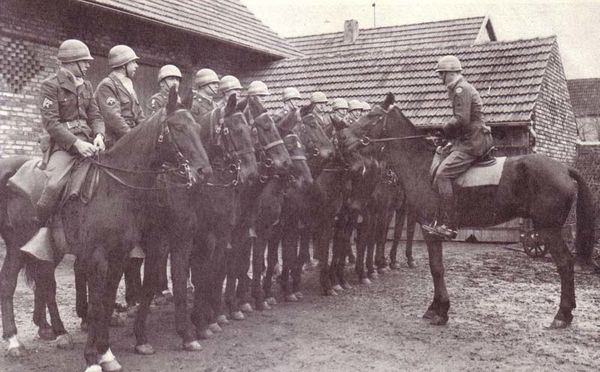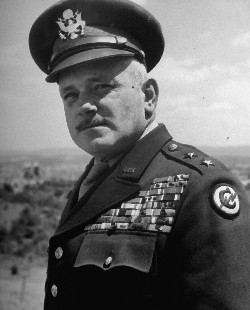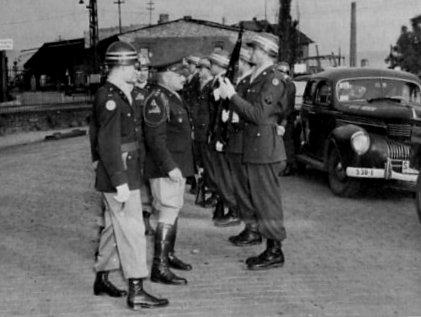"Circle-C Cowboys" corralled crime in Occupied Germany -1946 t0 1950
Mar 29, 2017 01:42:40 #
The armed U.S. Constabulary -- also known as the "Circle-C Cowboys" -- clearly meant business. They were a post-WW II elite recreation of the U.S. Cavalry troops from America's historic Wild West, roaming the American Occupation Zone to "keep the peace" in defeated Germany. They had the authority to arrest anybody inside the American Zone.
Each Constabulary regiment included an impressive horse-mounted platoon of 30 armed troopers riding ex-Nazi German Wehrmacht and SS horses trained for military duty. We "liberated" about 300 such horses.
Of course, the U.S. Constabulary also had heavier mechanized Cavalry equipment. Each of the 15 regiments included a light tank company of seventeen M24 tanks, M8 armored cars, 1-1/2-ton trucks, Jeeps, motorcycles and nine L-5 liaison aircraft.
Every trooper wore prominent circular shoulder and helmet patches: yellow background within a blue border, and a large blue C crossed by a red lightning bolt, which explains the "Circle-C" nickname. Their shiny lacquered helmet liners were ringed by two stripes, yellow and blue.
All on-duty troopers carried weapons, usually 45-cal. pistols, and wore unmistakably ""different" uniforms, including golden yellow neck scarves, "Sam Brown" belts, riding breeches (for mounted troops), and highly polished boots instead of the standard issue rough two-buckle combat boots.
The resemblance to State Highway troopers was deliberate.
The necessity for such an organization became clear to top Army officials in late 1945, due to increasing lawlessness and lax discipline including rampant black-marketeering and AWOLs among Occupation troops.
In May, 1945, there were 1,622,000 soldiers in the American Occupation Zone; nobody knew for sure how many Germans and other nationalities. There were practically no German vehicles on the streets and highways, but between June and November, 1945, the Americans racked up 7,800 motor vehicle accidents -- one of which cost General George C. Patton his life.
In January, 1946, the Army brass finally had enough, and they conceived the U.S. Constabulary. The first member, and commander, of this force was 52-year-old Major General Ernest Harmon, a fabled -- and profane -- Cavalry commander in both World Wars and a colleague of Patton. Working from scratch, he organized, equipped, trained, and fielded the elite Constabulary in only six months while the Occupation Army was deep in the turmoil of demobilization.
Because Harmon was short in both temper and height, some nicknamed him the "Pocket Patton." His personal guards were all six-footers. His soldiers called him "Old Gravel Voice."
The 30,000-man Constabulary, divided into 48 squadrons, was the only self-contained, armed U.S. military force having the extraordinary authority to cruise through almost the entire American Occupation Zone and arrest both Americans and Germans as well as any stray foreigners. Prisoners were turned over to appropriate authorities for prosecution or discipline.
The Constabulary also enforced Occupation laws among the Germans, in support of Military Government. The troopers checked in with every Burgermeister during patrols. Smaller towns and villages reportedly loved having the Constabulary around because, unlike the ordinary GIs, these troopers radiated disciplined authority and protection against marauders and criminals.
A primary assignment was patrolling the Zone's borders (1,500 miles) as well as the German super-highways, byways and back-country roads, The 41,000 square miles of the Zone included mountainous remote locations that often served as hideouts for lawbreakers. The U.S. Constabulary made many "swoop raids" (officially, check and search operations) to end organized criminal activities, including gangs inside refugee camps.
(One late-night raid was cancelled in mid-swoop when the speeding convoy smashed into a Bavarian farmer's "honey wagon," showering the men, weapons and vehicles with a stinking soup of human and animal wastes. No Circle-C horses were involved.)
In their first six months, the troopers uncovered 2,681 black-marketeering operations and 173 subversive acts. During the same period, the liaison aircraft flew more than 14,000 hours on 11,000 missions.
Three-man Jeep patrols were created, combining two troopers with an unarmed German policeman, who served as a translator when necessary. They hired former German soldiers who had been POWs in America and were fluent in English. Gradually, these Germans took over the policing duties as the Constabulary's assignments were reduced.
The U.S. Constabulary existed from 1946 to 1950, when it was absorbed into the Seventh Army. Many of its veterans reportedly were hired as troopers by various State Police back in the U.S.A.
Each Constabulary regiment included an impressive horse-mounted platoon of 30 armed troopers riding ex-Nazi German Wehrmacht and SS horses trained for military duty. We "liberated" about 300 such horses.
Of course, the U.S. Constabulary also had heavier mechanized Cavalry equipment. Each of the 15 regiments included a light tank company of seventeen M24 tanks, M8 armored cars, 1-1/2-ton trucks, Jeeps, motorcycles and nine L-5 liaison aircraft.
Every trooper wore prominent circular shoulder and helmet patches: yellow background within a blue border, and a large blue C crossed by a red lightning bolt, which explains the "Circle-C" nickname. Their shiny lacquered helmet liners were ringed by two stripes, yellow and blue.
All on-duty troopers carried weapons, usually 45-cal. pistols, and wore unmistakably ""different" uniforms, including golden yellow neck scarves, "Sam Brown" belts, riding breeches (for mounted troops), and highly polished boots instead of the standard issue rough two-buckle combat boots.
The resemblance to State Highway troopers was deliberate.
The necessity for such an organization became clear to top Army officials in late 1945, due to increasing lawlessness and lax discipline including rampant black-marketeering and AWOLs among Occupation troops.
In May, 1945, there were 1,622,000 soldiers in the American Occupation Zone; nobody knew for sure how many Germans and other nationalities. There were practically no German vehicles on the streets and highways, but between June and November, 1945, the Americans racked up 7,800 motor vehicle accidents -- one of which cost General George C. Patton his life.
In January, 1946, the Army brass finally had enough, and they conceived the U.S. Constabulary. The first member, and commander, of this force was 52-year-old Major General Ernest Harmon, a fabled -- and profane -- Cavalry commander in both World Wars and a colleague of Patton. Working from scratch, he organized, equipped, trained, and fielded the elite Constabulary in only six months while the Occupation Army was deep in the turmoil of demobilization.
Because Harmon was short in both temper and height, some nicknamed him the "Pocket Patton." His personal guards were all six-footers. His soldiers called him "Old Gravel Voice."
The 30,000-man Constabulary, divided into 48 squadrons, was the only self-contained, armed U.S. military force having the extraordinary authority to cruise through almost the entire American Occupation Zone and arrest both Americans and Germans as well as any stray foreigners. Prisoners were turned over to appropriate authorities for prosecution or discipline.
The Constabulary also enforced Occupation laws among the Germans, in support of Military Government. The troopers checked in with every Burgermeister during patrols. Smaller towns and villages reportedly loved having the Constabulary around because, unlike the ordinary GIs, these troopers radiated disciplined authority and protection against marauders and criminals.
A primary assignment was patrolling the Zone's borders (1,500 miles) as well as the German super-highways, byways and back-country roads, The 41,000 square miles of the Zone included mountainous remote locations that often served as hideouts for lawbreakers. The U.S. Constabulary made many "swoop raids" (officially, check and search operations) to end organized criminal activities, including gangs inside refugee camps.
(One late-night raid was cancelled in mid-swoop when the speeding convoy smashed into a Bavarian farmer's "honey wagon," showering the men, weapons and vehicles with a stinking soup of human and animal wastes. No Circle-C horses were involved.)
In their first six months, the troopers uncovered 2,681 black-marketeering operations and 173 subversive acts. During the same period, the liaison aircraft flew more than 14,000 hours on 11,000 missions.
Three-man Jeep patrols were created, combining two troopers with an unarmed German policeman, who served as a translator when necessary. They hired former German soldiers who had been POWs in America and were fluent in English. Gradually, these Germans took over the policing duties as the Constabulary's assignments were reduced.
The U.S. Constabulary existed from 1946 to 1950, when it was absorbed into the Seventh Army. Many of its veterans reportedly were hired as troopers by various State Police back in the U.S.A.
A U.S. Constabulary unit prepares for a patrol - Occupied Germany 1946

Gen. Ernest Harmon wearing Constabulary patch - 1946

General Harmon inspecting his 6-ft. personal guards

Mar 29, 2017 02:35:28 #
Mar 29, 2017 02:50:32 #
RichardQ wrote:
The armed U.S. Constabulary -- also known as the &... (show quote)
Yes, interesting. Never heard about this before (I'm only 62). Thanks for posting.
I have a just post war "German" 35mm Certo camera from my Father-In-Law tagged "USSR Occupied Germany". Though, why is it written in English and not German or Russian?
Mar 29, 2017 03:17:00 #
This is fascinating. I have study the second world war at length,
but never heard of this unit before.
Thank you for posting. Some more research I think.
but never heard of this unit before.
Thank you for posting. Some more research I think.
Mar 29, 2017 20:15:28 #
RichardTaylor wrote:
Very interesting.
Thanks Richard.
Thanks Richard.
Hi, Richard! Thanks for the comment. uch appreciated.
Mar 29, 2017 21:20:04 #
lamiaceae wrote:
Yes, interesting. Never heard about this before (I'm only 62). Thanks for posting.
I have a just post war "German" 35mm Certo camera from my Father-In-Law tagged "USSR Occupied Germany". Though, why is it written in English and not German or Russian?
I have a just post war "German" 35mm Certo camera from my Father-In-Law tagged "USSR Occupied Germany". Though, why is it written in English and not German or Russian?
Hi, lamiaceae! If you'd like some info on Certo cameras, try http://camera-wiki.org/wiki/Certo
Their factory was in Dresden, also home of the famous Exacta and Praktica SLR cameras. The Certo folding camera models were built from 1924 to the start of WW II; the flagship model was the Super Doliina. During the war, whiie the factory turned out cigarette rolling machines(!), the camera machinery was hidden in the homes of the employees. The Super Dollina production reportedly was started again in 1946, but the Russian occupiers wanted everything delivered to the Soviet Union as war reparations. That reportedly ended about 1950 when the firm became a private company. When the owner, Fritz von der Gönna. died in 1958, the Socialist East German government seized 30% ownership. The state finally took over completely in 1972. The last Certo cameras were made in 1982.
Perhaps some Russki official in their Occupation decided to tag some cameras with that ID so they would be an attractive souvenir for Americans (we were the only people buying souvenirs in those days ). But we were not in Dresden, so I can't even guess how your father-in-law got hold of that camera -- unless he was in Berlin, practically the only place where an American GI could buy something from a Russian.
Mar 30, 2017 07:16:16 #
richosob
Loc: Lambertville, MI
RichardQ wrote:
The armed U.S. Constabulary -- also known as the &... (show quote)
Another great story Richard, love to read your posts about the war, God bless you.
Rich
Mar 30, 2017 09:48:44 #
An interesting fact,After the war Berlin was divided into four zones.Russian.American,Brtish and French.Drunken Russians sometimes entered other zones and made trouble. The British military police beat them up and threw them back but the Alerican military police took a tougher line and sometimes shot them as a deterrent.f
Mar 30, 2017 10:56:35 #
apparently in ww2 , Germany was not that mechanized , the 2 main mode of transportation during the war for the military , was on foot , and horses .horses were used to pull wagons , cannons and on . in ww1, 8 million horses died in battle .ww2 ??
Mar 30, 2017 12:44:52 #
agillot wrote:
apparently in ww2 , Germany was not that mechanized , the 2 main mode of transportation during the war for the military , was on foot , and horses .horses were used to pull wagons , cannons and on . in ww1, 8 million horses died in battle .ww2 ??
Mules were used in Italy
Mar 30, 2017 12:49:22 #
Thank you, that is a very interesting story of a group I had not heard of before, even though I have invested many hours of WWII publications, and I'm no Spring Chicken.
Thanks again
L*S
Thanks again
L*S
Mar 30, 2017 14:36:57 #
Another interesting and fascinating story from WW2. I look forward to your posts. They are always well written.
Mar 30, 2017 20:58:39 #
Leicaflex wrote:
This is fascinating. I have study the second world war at length,
but never heard of this unit before.
Thank you for posting. Some more research I think.
but never heard of this unit before.
Thank you for posting. Some more research I think.
Thank you for the comments, Leicaflex. Naturally, if you didn't know the Constabulary's name, you'd have difficulty finding any info about it. The Army wasn't particularly keen on publicizing it, since its main reason for existence was the breakdown of discipline in some of the Occupation troops. If you type
www.History.Army.Mil/Documents/BorderOps/ch2.htm
you should bring up a detailed 18-page illustrated history of the U.S. Constabulary. I think it was prepared in 1984. The U.S. Constabulary veterans have several different web pages with comments. Of course, there's Wikipedia's "United States Constabulary" page. The Army Historical Series published "The U.S. Army in the Occupation of Germany 1944-1946" (Dr. Earl F. Ziemke, 1976, paperback 477 p.), which describes the Constabulary on page 341. An earlier (1967) book by U.S. Brigadier General Franklin M. Davis, Jr., "Come as a Conqueror" (hardcover, 271 p.) describes the Constabulary on pages 167-174. Thank you for your interest.
Mar 30, 2017 21:03:55 #
richosob wrote:
Another great story Richard, love to read your posts about the war, God bless you.
Rich
Rich
Glad to provide you with these vignettes, Rich! Thanks for the comments.
Mar 30, 2017 23:04:47 #
viscountdriver wrote:
An interesting fact,After the war Berlin was divided into four zones.Russian.American,Brtish and French.Drunken Russians sometimes entered other zones and made trouble. The British military police beat them up and threw them back but the Alerican military police took a tougher line and sometimes shot them as a deterrent.f
The U.S. Constabulary was blocked out of several enclaves (Berlin. Nuremberg, Bremen, Frankfurt am Main), because those already had static security forces assigned by USFET. However, the Circle-C Cowboys had plenty of medium-to-large cities in their jurisdiction, including Munich. The horse troopers had their share of riot control incidents. As for Russian troops, the long border shared with the Soviet Zone was an increasingly tense source of friction. General Harmon maintained close relations with the Soviet commanders and described them as "very friendly" and "business-like" during the first year or so. "You keep to your side and we'll stay on ours," he said. "When, as it sometimes happens, troopers step over the line and are apprehended, they are treated very well by the Soviets. They get good food and are courteously handled, as Soviet soldiers are treated after they cross into the U.S. Zone." That changed.
If you want to reply, then register here. Registration is free and your account is created instantly, so you can post right away.






